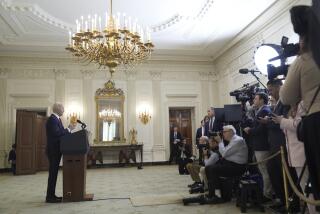McCain found to get more bad press
- Share via
Media coverage of the presidential race has not always been glowing for Barack Obama, but it has clearly been negative for John McCain, according to a survey of newspaper, Internet and television news since the political conventions.
Slightly fewer than a third of the stories about Obama were negative, whereas more than a third were positive and about the same number were neutral or mixed. More than half of the stories about McCain cast him in a negative light, whereas fewer than 2 in 10 were positive, according to Pew Research Center’s Project for Excellence in Journalism.
The media watchdog group assessed the tone of the campaign coverage during the six crucial weeks from early September through the final presidential debate, examining 857 stories from 43 news outlets.
Although the authors acknowledged some observers would use the findings to argue that the major media have a pro-Obama bias, they said their data did not provide conclusive answers. They noted that coverage of Republicans and Democrats in this and other recent presidential elections seemed to have more to do with their success than with their party affiliation.
The group’s research in 2000, for example, found that Democrat Al Gore got a level of negative coverage almost identical to the level Republican McCain is now receiving. Coverage of then-Gov. George W. Bush that year was more positive than Gore’s, but more negative than Obama’s has been this time.
The findings present “a strong suggestion that winning in politics begat winning coverage,” the Washington-based group found. “Obama’s coverage was negative in tone when he was dropping in the polls, and became positive when he began to rise, and it was just so for McCain.”
(The entire study is available at www.journalism.org.)
The Republican vice presidential nominee, Sarah Palin, saw her media coverage shift from largely positive to largely negative over the six-week period, as reporters increasingly probed her record and examined her sometimes bumpy television interviews.
About 2 in 5 of the stories about the Alaska governor had a negative tone, whereas fewer than a third were positive and a third were neutral or mixed, the study found.
The findings seemed to debunk Palin backers’ assertions that her negative coverage focused on personal and family issues: Only 5% of stories were aimed at those topics.
“The invisible man” of the general election campaign has been Democratic vice presidential nominee Joe Biden, the review found, noting that he was the dominant figure in 6% or less of campaign coverage in each week studied -- except for the week he debated Palin.
Other than relatively positive coverage of that lone debate, the Delaware senator’s coverage was found to be “far more negative than Palin’s, and nearly as negative as McCain’s.”
The project’s research appears to show how coverage of the candidates has changed over time. In early 2007, before he emerged as the front-runner for the Democratic nomination, Obama drew three times as many positive stories as negative ones. Somewhat more critical and mixed coverage emerged as Hillary Rodham Clinton engaged Obama in a protracted series of primaries. And since the political conventions, the tone toward the Democrat has bounced around.
As economic turmoil gripped the nation in late September, for example, Obama ticked up with stories like one on AOL News that noted, “Recent economic woes have given Democrat Barack Obama a clear lead over Republican John McCain.”
A couple of weeks later, though, McCain got some traction by raising doubts about Obama’s past, the study noted. It cited as one example an Oct. 7 Los Angeles Times story that said: “Barack Obama’s campaign was nearly swamped this spring when his pastor’s inflammatory sermons were widely publicized. . . . Now John McCain, trailing in the polls, is reviving questions about Obama’s past.”
But the more powerful trend, running against the Republican, was the financial crisis and coverage of McCain’s attempts to seize the initiative. Stories on that subject (including accounts of his declaration that the “fundamentals of the economy are strong”) were four times as likely to cast McCain in a negative light than in a positive one, the review found.
The Pew research group focused on a variety of news outlets, including the television networks, MSNBC, Fox News, websites and 13 newspapers.
Although other organizations have measured individual assertions about the candidates in news stories, the Pew researchers said they assessed the overall impression the public was likely to take away from each piece. For a story to be deemed as having a negative or positive tone, it had to be clearly so. To be judged negative, for example, the negative assertions in a story had to outweigh other assertions by a margin of at least 1.5 to 1.
As in previous election seasons, the watchdog group found the media focused heavily on the horse-race aspects of the campaign, though less so than in the last couple of presidential contests. More than half of the stories focused on tactics, strategy, polling and the like.
A little more than 1 in 5 stories focused on policy. And even in those stories, journalists tended to lean toward how the candidates’ proposals played with the body politic.
--
More to Read
Get the L.A. Times Politics newsletter
Deeply reported insights into legislation, politics and policy from Sacramento, Washington and beyond. In your inbox twice per week.
You may occasionally receive promotional content from the Los Angeles Times.











